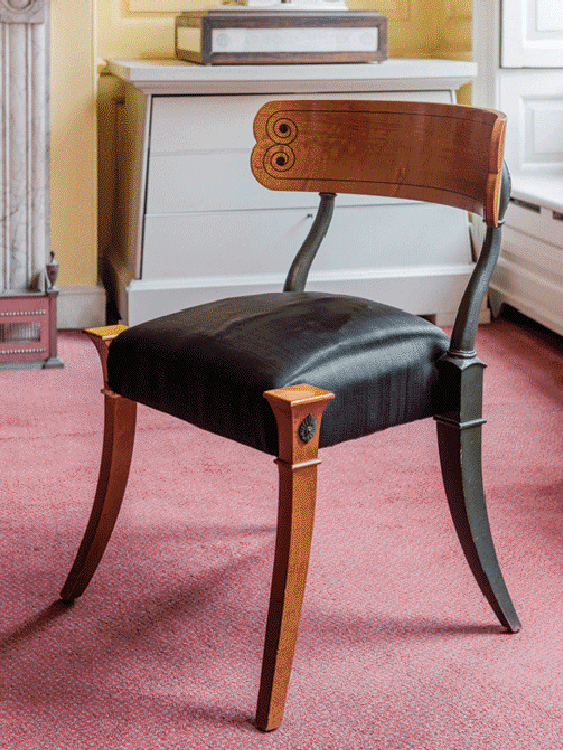
Klismos chairs designed for the Fellows' Dining Room at Gonville and Caius College, Cambridge, United Kingdom
Gonville and Caius College
Cambridge, UK
"Like his architecture, Simpson’s furniture is classical as well being strikingly inventive and practical, often including highly ingenious cupboards. The importance which he attaches to relating his buildings to their setting and to existing adjacent buildings extends to the way in which wherever possible he designs key pieces of furniture to harmonise with his interiors. He frequently draws for models on antique couches, beds, and chairs, especially of the curvaceous klismos type. We have seen fine examples of such work in his interiors at Gonville and Caius College, Cambridge, Ashfold House, and the Myers Collection at Eton College. Also to be noted is the relation between his interiors and furniture in his own nineteenth-century house in Belsize Park, London, which he and his wife Erica bought in 1989. He has since restored and remodelled it, undoing the damage which had typically been done to it in the 1970s, including removal of all the decoration, including cornices, and the further degradation of the main spaces by dividing them into smaller rooms." (Professor David Watkin in his book “THE ARCHITECTURE OF JOHN SIMPSON, The Timeless Language of Classicism.” Rizzoli 2014)
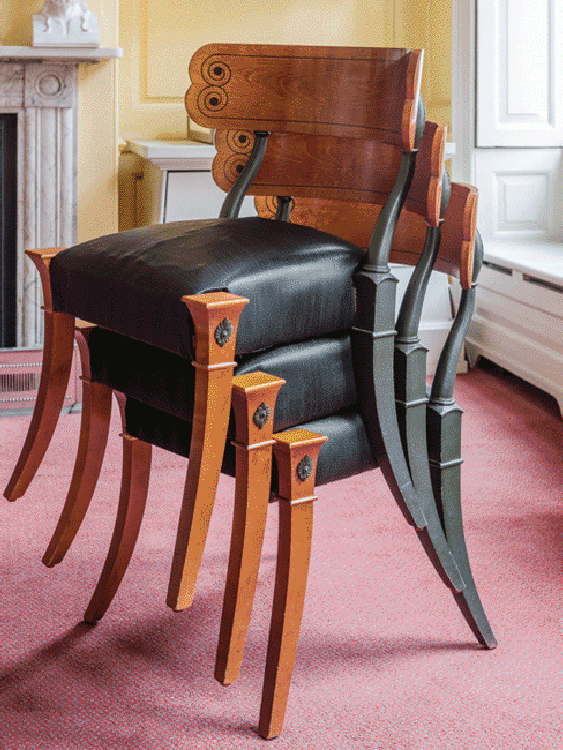
Stacking Klismos chairs designed for the Fellows' Dining Room at Gonville and Caius College, Cambridge, United Kingdom
Gonville and Caius College
Cambridge, UK
"Like his architecture, Simpson’s furniture is classical as well being strikingly inventive and practical, often including highly ingenious cupboards. The importance which he attaches to relating his buildings to their setting and to existing adjacent buildings extends to the way in which wherever possible he designs key pieces of furniture to harmonise with his interiors. He frequently draws for models on antique couches, beds, and chairs, especially of the curvaceous klismos type. We have seen fine examples of such work in his interiors at Gonville and Caius College, Cambridge, Ashfold House, and the Myers Collection at Eton College. Also to be noted is the relation between his interiors and furniture in his own nineteenth-century house in Belsize Park, London, which he and his wife Erica bought in 1989. He has since restored and remodelled it, undoing the damage which had typically been done to it in the 1970s, including removal of all the decoration, including cornices, and the further degradation of the main spaces by dividing them into smaller rooms." (Professor David Watkin in his book “THE ARCHITECTURE OF JOHN SIMPSON, The Timeless Language of Classicism.” Rizzoli 2014)
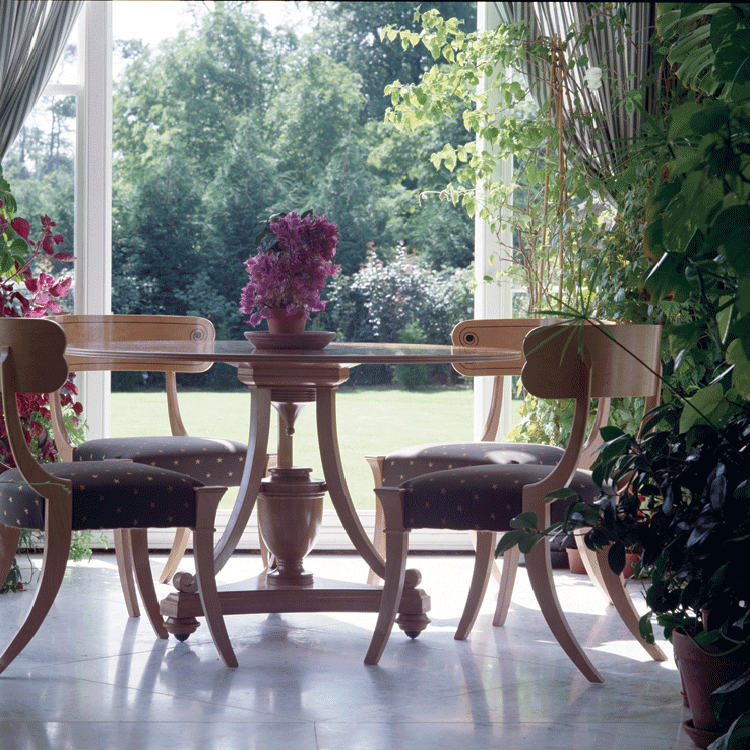
Conservatory at Ashfold House showing the Klismos chair and table design
Ashfold House
Sussex, UK
"Like his architecture, Simpson’s furniture is classical as well being strikingly inventive and practical, often including highly ingenious cupboards. The importance which he attaches to relating his buildings to their setting and to existing adjacent buildings extends to the way in which wherever possible he designs key pieces of furniture to harmonise with his interiors. He frequently draws for models on antique couches, beds, and chairs, especially of the curvaceous klismos type. We have seen fine examples of such work in his interiors at Gonville and Caius College, Cambridge, Ashfold House, and the Myers Collection at Eton College. Also to be noted is the relation between his interiors and furniture in his own nineteenth-century house in Belsize Park, London, which he and his wife Erica bought in 1989. He has since restored and remodelled it, undoing the damage which had typically been done to it in the 1970s, including removal of all the decoration, including cornices, and the further degradation of the main spaces by dividing them into smaller rooms." (Professor David Watkin in his book “THE ARCHITECTURE OF JOHN SIMPSON, The Timeless Language of Classicism.” Rizzoli 2014)
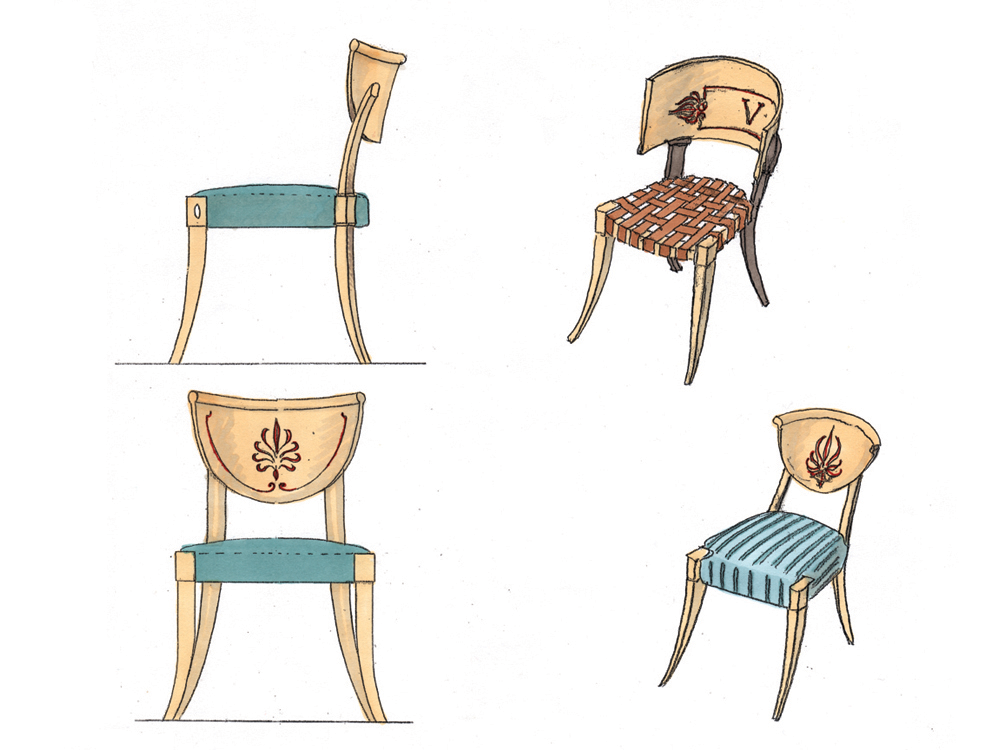
Sketches for dining chairs for Ashfold House, Sussex, United Kingdom
Ashfold House
Sussex, UK
"Like his architecture, Simpson’s furniture is classical as well being strikingly inventive and practical, often including highly ingenious cupboards. The importance which he attaches to relating his buildings to their setting and to existing adjacent buildings extends to the way in which wherever possible he designs key pieces of furniture to harmonise with his interiors. He frequently draws for models on antique couches, beds, and chairs, especially of the curvaceous klismos type. We have seen fine examples of such work in his interiors at Gonville and Caius College, Cambridge, Ashfold House, and the Myers Collection at Eton College. Also to be noted is the relation between his interiors and furniture in his own nineteenth-century house in Belsize Park, London, which he and his wife Erica bought in 1989. He has since restored and remodelled it, undoing the damage which had typically been done to it in the 1970s, including removal of all the decoration, including cornices, and the further degradation of the main spaces by dividing them into smaller rooms." (Professor David Watkin in his book “THE ARCHITECTURE OF JOHN SIMPSON, The Timeless Language of Classicism.” Rizzoli 2014)
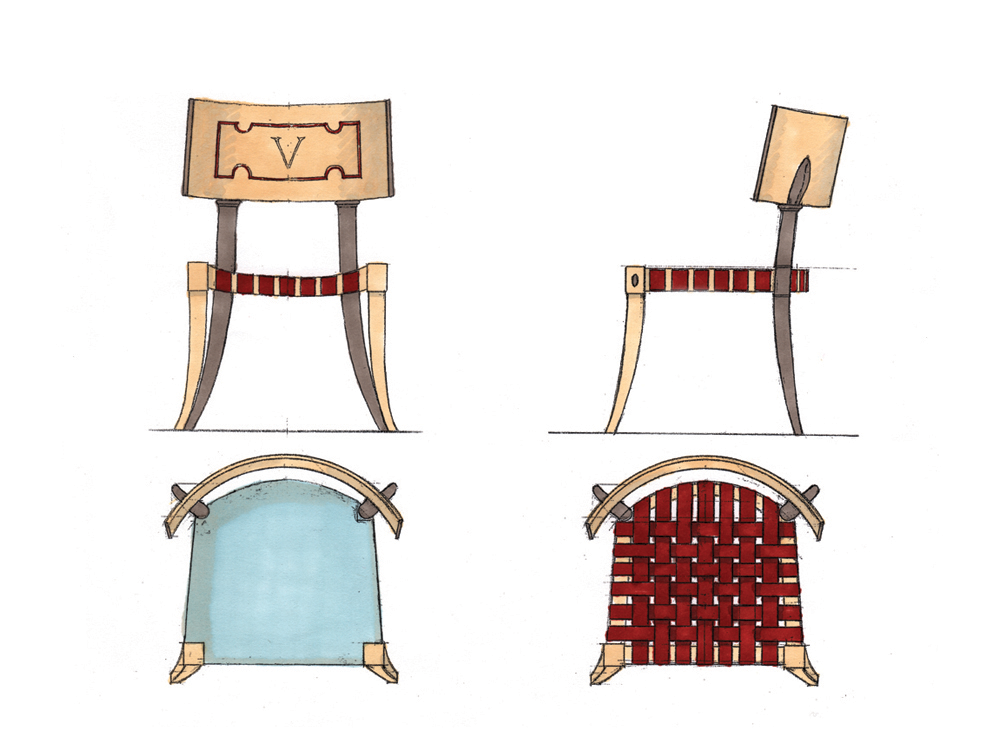
Sketches for dining chairs for Ashfold House, Sussex, United Kingdom
Ashfold House
Sussex, UK
"Like his architecture, Simpson’s furniture is classical as well being strikingly inventive and practical, often including highly ingenious cupboards. The importance which he attaches to relating his buildings to their setting and to existing adjacent buildings extends to the way in which wherever possible he designs key pieces of furniture to harmonise with his interiors. He frequently draws for models on antique couches, beds, and chairs, especially of the curvaceous klismos type. We have seen fine examples of such work in his interiors at Gonville and Caius College, Cambridge, Ashfold House, and the Myers Collection at Eton College. Also to be noted is the relation between his interiors and furniture in his own nineteenth-century house in Belsize Park, London, which he and his wife Erica bought in 1989. He has since restored and remodelled it, undoing the damage which had typically been done to it in the 1970s, including removal of all the decoration, including cornices, and the further degradation of the main spaces by dividing them into smaller rooms." (Professor David Watkin in his book “THE ARCHITECTURE OF JOHN SIMPSON, The Timeless Language of Classicism.” Rizzoli 2014)
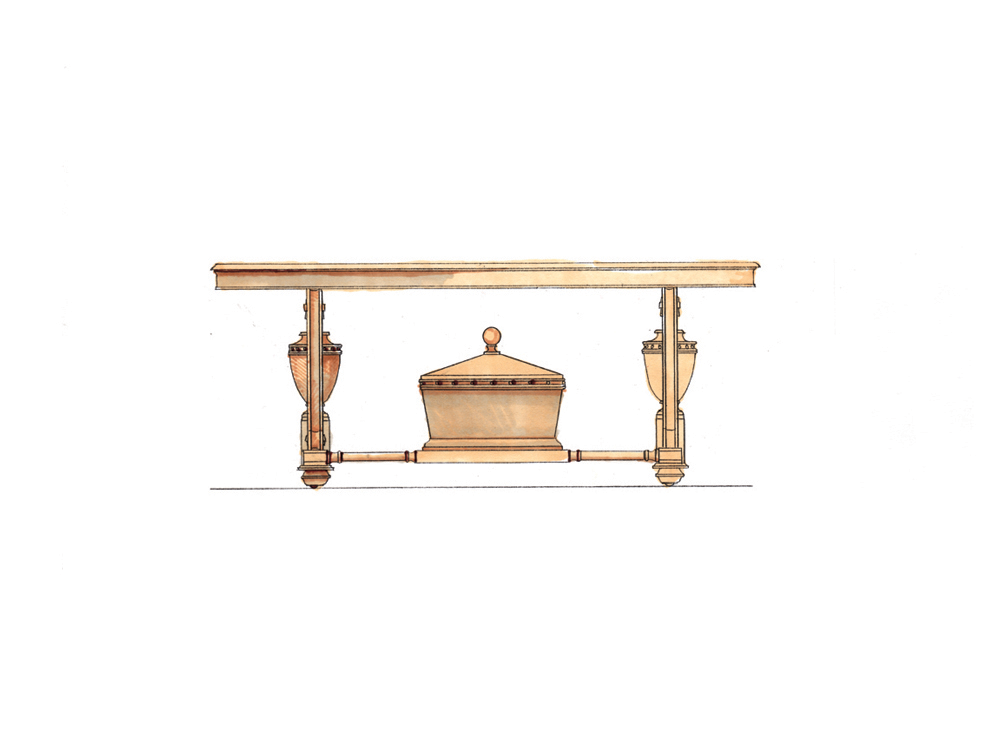
Drawing of a console table, Gonville and Caius College, Cambridge, United kingdom
Gonville and Caius College
Cambridge, UK
"Like his architecture, Simpson’s furniture is classical as well being strikingly inventive and practical, often including highly ingenious cupboards. The importance which he attaches to relating his buildings to their setting and to existing adjacent buildings extends to the way in which wherever possible he designs key pieces of furniture to harmonise with his interiors. He frequently draws for models on antique couches, beds, and chairs, especially of the curvaceous klismos type. We have seen fine examples of such work in his interiors at Gonville and Caius College, Cambridge, Ashfold House, and the Myers Collection at Eton College. Also to be noted is the relation between his interiors and furniture in his own nineteenth-century house in Belsize Park, London, which he and his wife Erica bought in 1989. He has since restored and remodelled it, undoing the damage which had typically been done to it in the 1970s, including removal of all the decoration, including cornices, and the further degradation of the main spaces by dividing them into smaller rooms." (Professor David Watkin in his book “THE ARCHITECTURE OF JOHN SIMPSON, The Timeless Language of Classicism.” Rizzoli 2014)
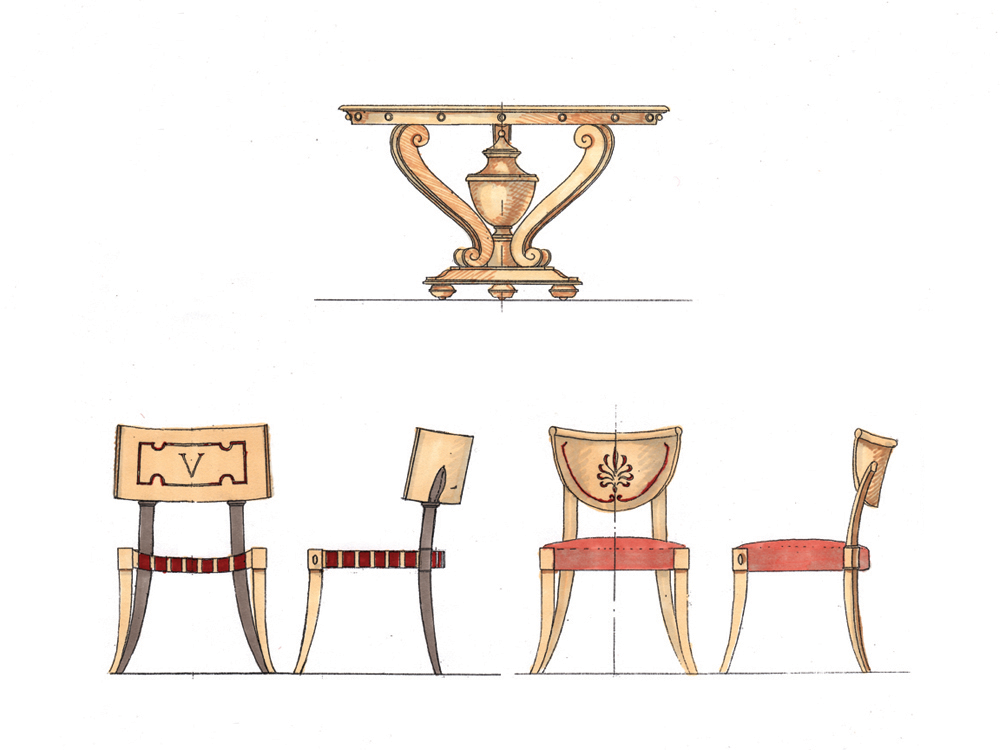
Sketches for dining chairs and a round table supported on three brackets arranged around a central urn, Ashfold House, Sussex, United Kingdom
Ashfold House
Sussex, UK
"Like his architecture, Simpson’s furniture is classical as well being strikingly inventive and practical, often including highly ingenious cupboards. The importance which he attaches to relating his buildings to their setting and to existing adjacent buildings extends to the way in which wherever possible he designs key pieces of furniture to harmonise with his interiors. He frequently draws for models on antique couches, beds, and chairs, especially of the curvaceous klismos type. We have seen fine examples of such work in his interiors at Gonville and Caius College, Cambridge, Ashfold House, and the Myers Collection at Eton College. Also to be noted is the relation between his interiors and furniture in his own nineteenth-century house in Belsize Park, London, which he and his wife Erica bought in 1989. He has since restored and remodelled it, undoing the damage which had typically been done to it in the 1970s, including removal of all the decoration, including cornices, and the further degradation of the main spaces by dividing them into smaller rooms." (Professor David Watkin in his book “THE ARCHITECTURE OF JOHN SIMPSON, The Timeless Language of Classicism.” Rizzoli 2014)
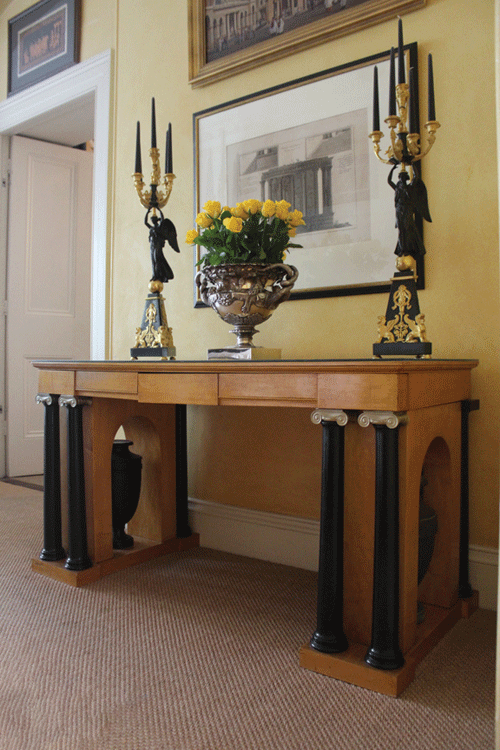
Ionic sideboard with supporting arches containing urns, Belsize Park, London, United Kingdom
Belsize Park
London, UK
"Like his architecture, Simpson’s furniture is classical as well being strikingly inventive and practical, often including highly ingenious cupboards. The importance which he attaches to relating his buildings to their setting and to existing adjacent buildings extends to the way in which wherever possible he designs key pieces of furniture to harmonise with his interiors. He frequently draws for models on antique couches, beds, and chairs, especially of the curvaceous klismos type. We have seen fine examples of such work in his interiors at Gonville and Caius College, Cambridge, Ashfold House, and the Myers Collection at Eton College. Also to be noted is the relation between his interiors and furniture in his own nineteenth-century house in Belsize Park, London, which he and his wife Erica bought in 1989. He has since restored and remodelled it, undoing the damage which had typically been done to it in the 1970s, including removal of all the decoration, including cornices, and the further degradation of the main spaces by dividing them into smaller rooms." (Professor David Watkin in his book “THE ARCHITECTURE OF JOHN SIMPSON, The Timeless Language of Classicism.” Rizzoli 2014)